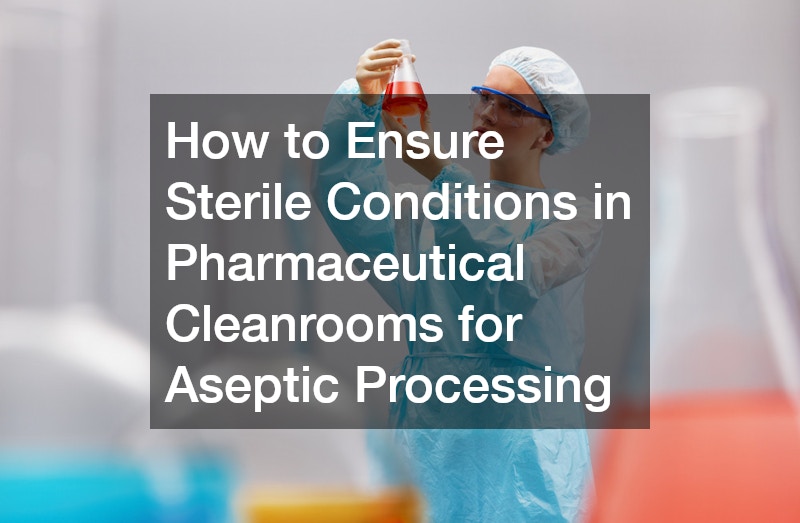The integrity of sterile products carries weight in the pharmaceutical industry. Consequently, the cleanroom environment where aseptic processing occurs must be meticulously maintained to prevent contamination and ensure product safety. Proper cleanroom design, maintenance, and operational practices play a critical role in achieving these goals. Here’s a comprehensive guide to cleanroom maintenance for aseptic processing.
1. The Importance of Cleanroom Design
A well-designed cleanroom is the cornerstone of effective aseptic processing. Its primary purpose is to safeguard the sterility of products by controlling the environment in which they are manufactured.
Key Design Considerations
Cleanrooms should be designed to maintain positive pressure differentials between sterile and non-sterile areas, which keeps contaminants off the clean zones. A positive pressure differential of at least 10 to 15 Pascal is recommended. Additionally, high-efficiency particulate air (HEPA) filters are crucial for removing airborne contaminants, ensuring that the air inside the cleanroom is of higher quality than the air outside to prevent contamination.
Flooring Requirements
An often overlooked but essential element in cleanroom design is the choice of flooring. Partnering with a reputable pharmaceutical flooring company can ensure that the flooring materials meet the stringent requirements for cleanliness and durability. High-quality pharmaceutical flooring helps minimize the risk of contamination by providing a seamless, non-porous surface that is easy to clean and resistant to chemical damage.
2. Maintaining Air Quality
Air quality is a critical factor in maintaining a sterile environment. With proper control of particulate matter and airflow, the cleanroom remains free from contaminants that could compromise product sterility.
Particle Control
Regular monitoring of particulate levels is essential to ensure that the air is continuously filtered to remove particles and maintain the desired cleanliness levels.
Airflow Management
Unidirectional airflow is employed to prevent the accumulation of contaminants. Ensuring that air flows smoothly in a controlled direction minimizes the risk of contamination from airborne particles.
3. Operational Best Practices
Even with the best design and equipment, cleanroom maintenance relies heavily on operational practices. These practices are crucial for minimizing the exposure of sterile products to potential contaminants.
Minimizing Exposure
To reduce the risk of contamination from airborne particles or other sources, it is important to minimize the time that sterile products are exposed to the environment. Equipment should be designed to prevent the entry of lower-quality air into critical areas, aiding in maintaining a controlled environment.
Flow of Personnel and Materials
Efficient flow of personnel and materials is essential. This includes designing workflows that prevent unnecessary movement and reduce the risk of contamination.
Gowning Procedures
Proper gowning is crucial for preventing human-generated contamination. Personnel must adhere to stringent gowning procedures to maintain the sterility of the cleanroom environment, including wearing appropriate clothing, gloves, and masks.
3. Training and Techniques
Personnel training is an integral part of maintaining a sterile environment. Comprehensive training programs should cover hygiene practices, safety protocols, and the specific procedures relevant to aseptic processing.
Training Programs
Training enables all individuals working in the cleanroom to properly handle sterile materials and equipment properly, minimizing the risk of introducing contaminants. Proper training in aseptic techniques, including handling sterile materials and equipment, is essential.
Best Practices for Maintaining Sterility
Best practices for maintaining sterility involve using sterile instruments exclusively for handling sterile materials to prevent contamination. Controlled, deliberate movements help avoid disrupting controlled airflow patterns and minimize the risk of introducing contaminants. Make sure that all personnel are properly gowned to control human-generated contamination is crucial. This includes wearing appropriate clothing, gloves, and masks.
4. The Role of Clean Areas
Clean areas serve as zones where non-sterile components and materials are processed before being transferred to sterile environments. Maintaining cleanliness in these areas is essential for overall product quality.
Design and Maintenance
Clean areas should be designed to minimize particle contamination, with regular cleaning and maintenance necessary to keep these areas free from contaminants.
Process Flow
The flow of materials from clean areas to sterile processing areas must be carefully controlled to prevent contamination.
In Summary
Being acquainted with proper cleanroom maintenance for aseptic processing is essential for ensuring the safety and efficacy of pharmaceutical products. By focusing on cleanroom design, air quality control, operational best practices, and personnel training, you can uphold the highest standards of product integrity. Regular reviews and adherence to these guidelines will help maintain a controlled environment, ultimately leading to the production of safe and effective pharmaceutical products.
.





